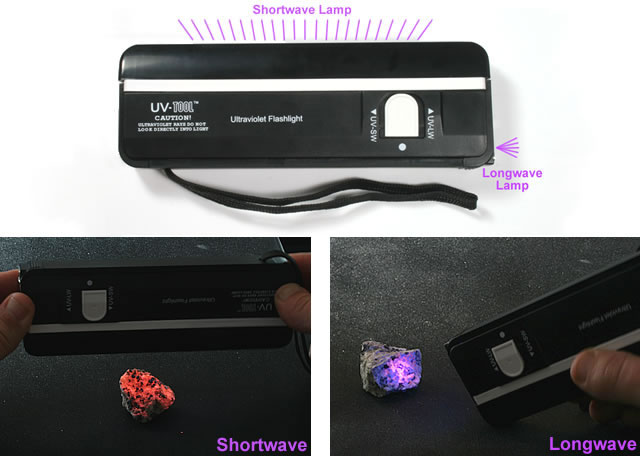The M12 Ultraviolet (UV) Flashlight and Lamp

This inexpensive lamp produces both longwave (move the switch to the UV-LW or TORCH position) and shortwave ultraviolet light (move the switch to the UV-SW or TUBE position) for examining fluorescent minerals and other items. It has an effective illumination distance of 6 to 12 inches, making it a good lamp for classroom, office, and close fieldwork. It is not powerful enough to search for fluorescent minerals in the field while walking. It requires four AA batteries (not provided) for operation. UV-blocking eye protection should be worn while using this lamp. Two pairs of UV-blocking safety glasses are included with the lamp. See full details below the related items.
| UV Lamp Safety Exposure to shortwave or longwave UV light can cause skin and eye injury. Do not look into a UV lamp. Take care not to shine the lamp towards the face of a person or pet, and do not shine it directly onto the skin. Eye protection should be used at all times while using the M12 lamp. UV-blocking safety glasses or UV-blocking prescription glasses should be worn. Clothing that covers the arms, legs, hands and feet should be worn if this UV lamp will be used for extended periods. |
A Low-Cost Ultraviolet Light Source
People who want to examine fluorescent minerals, postage stamps, currency, art glass, gems and other items are often discouraged because the price of an ultraviolet lamp is so high. The M12 UV lamp is a low-cost light source for examining small objects using either longwave (move the switch to the UV-LW or TORCH position) or shortwave (move the switch to the UV-SW or TUBE position) ultraviolet light. It operates using four AA batteries (not provided).
The M12 lamp has an effective illumination distance of about six to twelve inches. That makes it a good light source for desktop examination of specimens. It can be used in the field for close examination of specimens, but the light sources are not strong enough to search for fluorescent items on the ground or in outcrops while walking.
Darkness Required for Best Viewing
Most objects that respond to a UV light have a response that is too subtle to be seen under normal daylight or under the normal illumination of a classroom or office. Fluorescent objects are best observed by taking them into a dark room or closet and illuminating them with the ultraviolet lamp. The darker the surroundings, the better you will be able to observe a fluorescent response, especially if that response is weak.
Longwave UV Flashlight
The M12 lamp functions as a longwave ultraviolet flashlight. Just push the on/off switch to the (move the switch to the UV-LW or TORCH position) position, and the LED bulb on the front of the case will produce a beam of longwave (375nm) UV light. This light is similar to the illumination produced by the "blacklights" sold in party and novelty stores. Many common objects will fluoresce when illuminated with longwave UV light.
If you are using this lamp for UV studies of minerals and gems, only about 10% of fluorescent specimens have an obvious response to longwave UV light. About 90% require shortwave UV illumination to display their fluorescent properties. A few minerals respond to both shortwave and longwave UV illumination.
Shortwave UV Lamp
The M12 has a four-watt fluorescent tube that emits shortwave (254nm) UV light. When the on/off switch is moved to the (move the switch to the UV-SW or TUBE position) position, the fluorescent tube is activated and shortwave light shines through the optical filter window on the top of the case. This is the type of UV light that most fluorescent minerals respond to.
Specifications
- Power: Requires four AA batteries (not provided).
- Case Size: 6 ½" long, 2 ¼" wide, ¾" thick.
- Weight: 3 ounces without batteries.
- Weight: 6 ounces with batteries.
- Warranty: 90 days.
Learn More About Fluorescent Minerals
If you are interested in learning more about fluorescent minerals, Geology.com has an introductory article that is free for anyone to read. We sell fluorescent mineral collections that contain a number of minerals that respond to the lamp sold above. Finally, we offer two popular books by Stuart Schneider: Collecting Fluorescent Minerals and The World of Fluorescent Minerals.
Related Fluorescent Items
 Collecting Fluorescent Minerals |
 The World of Fluorescent Minerals |
 Fluorescent Mineral Collection |
